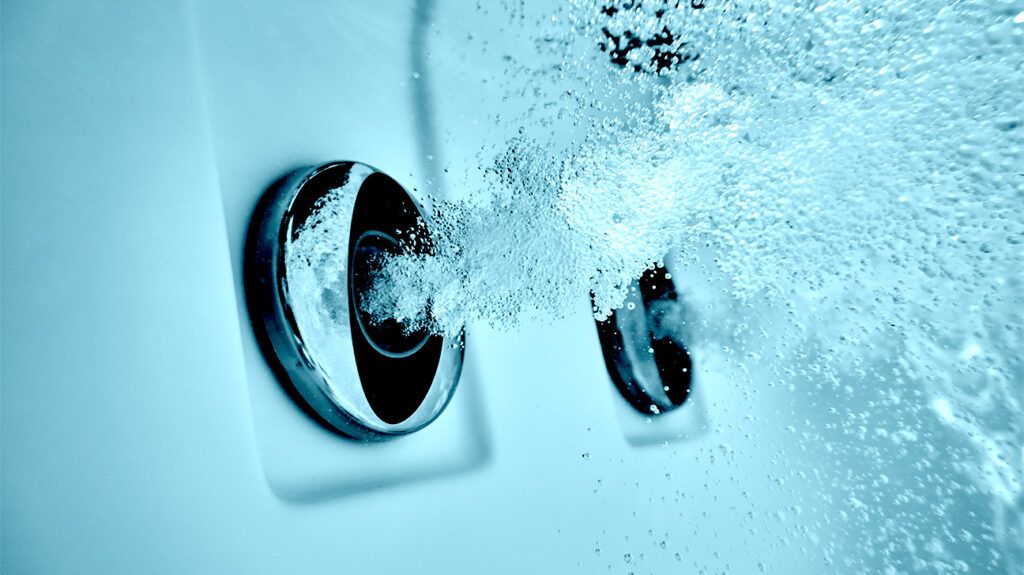Hot tub folliculitis is a skin infection with bacteria called Pseudomonas aeruginosa, and the cause is usually using a poorly maintained hot tub. Other names for the condition are jacuzzi folliculitis, pseudomonas folliculitis, and hot tub rash.
P. aeruginosa bacteria can multiply rapidly in wet, warm conditions. If water with bacteria stays on the skin for too long, the bacteria can infect the hair follicles and cause an eruption of itchy bumps.
The rash may appear a few hours or days after exposure to the bacteria. While it often clears up without treatment, it can cause systemic symptoms, such as a fever, malaise, and fatigue.
In this article, we explore the causes and symptoms of hot tub folliculitis in more detail, describe what the rash looks like, and explain how to treat it.

Hot tub folliculitis results from a bacterial infection in hair follicles on the skin. The bacteria, called P. aeruginosa, multiply in hot temperatures and thrive in conditions found in poorly maintained hot tubs. The bacteria can survive in chlorinated water.
The bacteria grow in other warm, wet environments, such as:
- pools containing bacteria
- lakes and rivers
- water slides
- whirlpools
Learn more about folliculitis.
The main symptom of hot tub folliculitis is a rash of itchy bumps. The bumps may look similar to acne and may contain pus. They can appear red, purple, or discolored; the skin may seem inflamed and tender.
The rash can form anywhere but
People with hot tub folliculitis may also feel ill and have fatigue or a high temperature.
The rash and other symptoms may develop 12 to 48 hours after contact with the water.
Warning
Contains Sensitive Content
Hot tub folliculitis may clear up without treatment within 5 to 10 days, and it is usually harmless in otherwise healthy people. However, if the rash lasts longer or occurs with other symptoms, a person should receive medical advice.
Topical medications
A doctor may prescribe a topical medication, such as silver sulfadiazine cream, to treat hot tub folliculitis. People can apply this cream twice a day. However, it is always best to follow a doctor’s guidance.
The American Osteopathic College of Dermatology also recommends using white vinegar to treat hot tub folliculitis. People can apply this to the affected area for 20 minutes at a time, two to four times daily.
Always apply treatment for the skin in the same direction as any hair growth, and leave the area uncovered. Also, avoid shaving or scratching the area to prevent further skin irritation.
Oral antibiotics
A doctor may prescribe oral antibiotics if topical preparations do not treat hot tub folliculitis.
To soothe and help the area heal, a person can apply a warm compress for 15–20 minutes, three to four times a day, or as often as necessary.
Once the rash has cleared, it may leave marks on the skin. These may have discoloration and take a few months to disappear.
Contacting a healthcare professional is especially important for anyone with a health issue that affects their immune system or cystic fibrosis. The bacteria P. aeruginosa can cause pneumonia in people with cystic fibrosis.
A doctor diagnoses hot tub folliculitis by examining the skin and asking about the person’s medical history and recent exposure to hot tubs and pools.
The rash can look similar to:
- acne
- psoriasis
- other types of folliculitis
- other bacterial infections, such as a staph infection
- chemical rashes
To prevent a misdiagnosis, a doctor may swab the skin and send this sample to a laboratory for examination under a microscope. The analysis can confirm the type of infection.
Hot tub folliculitis is a skin infection people acquire from prolonged exposure to bacteria-containing water. The bacteria do not pass from person to person.
People can take steps to prevent hot tub folliculitis, such as:
- removing swimwear right after getting out of a hot tub and putting it in the wash
- showering with hot water and soap right after using a hot tub
- checking that a public hot tub has cleaners attending at least twice a day
- making sure that swimwear is completely dry before wearing it again
People should take extra care or avoid hot tub use if they have:
- areas of broken skin or open wounds
- a health condition that affects their immune system
- cystic fibrosis
People can keep their hot tubs clean and safe by:
- using test strips to check pH and disinfectant levels
- replacing the hot tub water regularly
- thoroughly cleaning all parts of the pool regularly
- following the manual’s instructions for replacing the water filter
The
- free chlorine, at 3–10 parts per million (ppm) or
- bromine, at 4–8 ppm and
- a pH of 7.0 to 7.8
To kill the bacteria in bath sponges, soak them in 1 gallon of water with three-quarters of a cup of chlorine bleach for at least 5 minutes. Then rinse them thoroughly before use.
How do you get rid of hot tub folliculitis?
Treatment for hot tub folliculitis includes topical medications such as silver sulfadiazine cream, as well as oral antibiotics.
What is the best antibiotic for hot tub folliculitis?
Oral antibiotics,
Does apple cider vinegar help hot tub folliculitis?
White vinegar can help clear hot tub folliculitis.
Hot tub folliculitis is a bacterial skin infection that a person might develop from using a poorly maintained hot tub or pool. It causes itchy bumps on the skin, particularly in areas that swimwear covers.
The infection may clear up in a few days without treatment, but contact a healthcare professional if it lasts 10 days or longer. The treatment may include topical medication or oral antibiotics.


